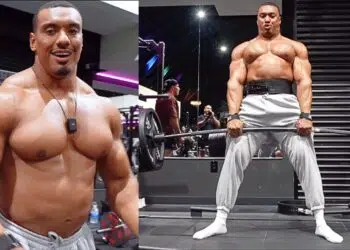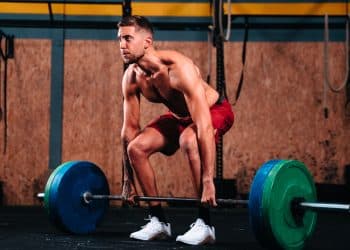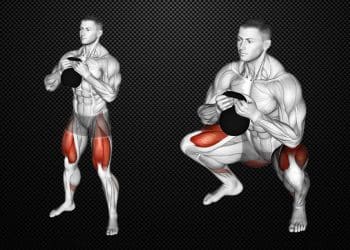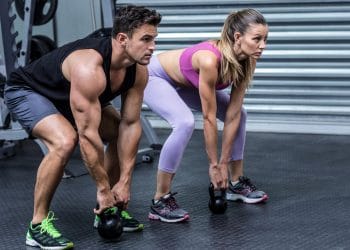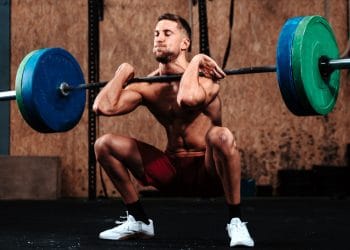Your body is made up of over 200 muscles. While nobody ever tries to train each one individually, many exercisers focus mainly on the large, obvious muscles, e.g., the quadriceps, pectoralis major, and latissimus dorsi.
Using a split routine, bodybuilders dedicate entire workouts to just one or two muscle groups, training each one once or twice a week.
While this approach is ideal for building bigger muscles, it’s not how things usually work in nature. Most meaningful movements involve your entire body, with almost every muscle group engaged simultaneously.
If you want to build real-world strength and power, perhaps for sport, you need to train your body as it works in nature. Not as individual body parts but as a single unit.
There are several great exercises that you can use to achieve this goal, but the sumo deadlift high pull could be one of the best.
In this guide, we explain why and how to do it. Plus, we reveal the seven best sumo deadlift high pull variations and alternatives.
Level Up Your Fitness: Join our 💪 strong community in Fitness Volt Newsletter. Get daily inspiration, expert-backed workouts, nutrition tips, the latest in strength sports, and the support you need to reach your goals. Subscribe for free!
Sumo Deadlift High Pull – Muscles Worked
Sumo deadlift high pulls combine two exercises – sumo deadlifts and upright rows. As such, they involve a lot of different muscles. The main muscles trained during sumo deadlift high pulls are:
Quadriceps
Located on the four of your thighs, the four quadriceps muscles are rectus femoris, vastus lateralis, vastus medialis, and vastus intermedius. These muscles work together to extend your knees, while the rectus femoris is also one of the hip flexors.
Hamstrings
Responsible for hip extension and knee flexion, the hamstrings are biceps femoris, semimembranosus, and semitendinosus. The hamstrings are the large, long muscle group located on the back of your thigh.
Gluteus maximums, medius, and minimus
The gluteal muscles are located on the back and sides of your hips. The Gluteus maximus is mainly responsible for hip extension, while the medius and minimus are more involved in hip abduction. Sumo deadlift high pulls give your glutes a great workout.
Erector spinae
Basically the muscles of your lower back, the erector spinae contract statically during sumo deadlift high pulls to prevent your spine from rounding. Their primary function is the extension of your lumbar spine.
Core
The collective term for the muscles of your midsection, your core muscles stabilize your lumbar spine by squeezing inward to create intra-abdominal pressure. The main core muscles are the rectus abdominus, transverse abdominus, and obliques.
Trapezius
This is the large diamond-shaped muscle that covers much of your upper back. There are three sets of trapezius fibers, upper, middle, and lower, and all three are involved in sumo deadlift high pulls. However, the upper and middle fibers are most active. They are responsible for the elevation and retraction of your shoulder girdle, respectively.
Deltoids
The deltoids are your shoulder muscles. There are three sets of deltoid fibers, often called heads; anterior (front), medial (middle), and posterior (rear). All three deltoid heads are active during sumo deadlift high pulls, with medial and posterior being the most active.
Biceps brachii
Located on the front of your upper arm, the biceps brachii flexes your elbow and helps you pull the weight up the front of your body. Usually just called the biceps, this two-headed arm muscle is probably the most well-known muscle in the human body. The biceps works with the brachioradialis and brachialis during sumo deadlift high pulls.
How to Do Sumo Deadlift High Pulls
Get more from sumo deadlift high pulls and keep your risk of injury to a minimum by following these guidelines:
- Place your barbell on the floor. Ideally, it should be about mid-shin height, as though you are using full-sized bumper plates.
- Stand with your toes under the bar. Your feet should be about 1.5 shoulder-widths apart, toes turned slightly outward.
- Reach down and hold the bar with an overhand, shoulder-width grip, so your arms are inside your legs. Your shoulders should be slightly in front of the bar.
- Brace your core, straighten your arms, pull your shoulders down and back, and adopt a neutral spine, i.e., slightly arched and not rounded. Your hips should be below shoulder height.
- Driving down through your heels and initially keeping your arms straight, explosively extend your legs and lift the bar upward.
- Just as your hips and knees near lockout, shrug your shoulders and pull with your arms, bring the bar up and under your chin. Keep your elbows up and out.
- Lower the weight back to your hips and then place it back on the floor.
Sumo Deadlift High Pull Benefits and Drawbacks
Benefits
Not sure if sumo deadlift high pulls deserve a place in your workouts? Consider these benefits:
A full-body exercise
There aren’t many exercises that work more muscles at the same time than sumo deadlift high-pulls. Pair them with push-ups or dips to work virtually every major muscle in just two exercises.
Easier to learn than the Olympic lifts
The clean and jerk and snatch share many similarities and benefits with sumo deadlift high pulls but are MUCH harder to learn. If you want to do power training but don’t want to spend time learning the Olympic lifts, the sumo deadlift high pull is a good alternative.
Get yoked!
If you want bigger traps, the sumo deadlift high pull can help. It’s basically a leg-assisted upright row, and upright rows are a very effective upper trap exercise. It’s also a good exercise for building bigger deltoids.
Versatile
Depending on how you load this exercise, sumo deadlift high pulls can be used to develop power, conditioning, or muscle mass. This means it’s suitable for almost anyone who lifts weights, irrespective of their training goal.
A potent posterior chain exercise
If you want to run faster, jump higher, lift heavier, or kick harder, the sumo deadlift high pull is an excellent choice. It targets your posterior chain, which is the collective name for the muscles on the back of your body. These muscles are the “power plant” responsible for many athletic activities.
Level Up Your Fitness: Join our 💪 strong community in Fitness Volt Newsletter. Get daily inspiration, expert-backed workouts, nutrition tips, the latest in strength sports, and the support you need to reach your goals. Subscribe for free!
Related: 5 Awesome Benefits Of Sumo Deadlift High Pulls
Drawbacks
While sumo deadlift high pulls are a mostly beneficial exercise, there are also a few drawbacks to consider:
Shoulder injuries
Sumo deadlift high pulls involve medial rotation of the shoulder joint combined with elevation of the shoulder girdle. Long story short, this puts your shoulders in a mechanically disadvantageous position that could cause shoulder pain or injury. If upright rows bother your shoulders, this is NOT the exercise for you.
Lower back injury
Explosive exercises like sumo deadlift high pulls tend to magnify technical faults, such as poor core strength or lack of positional awareness. These issues can lead to rounding the lumbar spine, which is a recipe for back pain and injuries. Make sure you know how to brace correctly before attempting this exercise.
Not for beginners
Newbie CrossFitters often do sumo deadlift high pulls; however, their technique leaves a LOT to be desired! This is a complex exercise that is not really suitable for beginners. Make sure you have mastered sumo deadlifts and upright rows before trying to combine these two exercises.
7 Sumo Deadlift High Pull Variations and Alternatives
Sumo deadlift high pulls are a highly effective full-body exercise, but that doesn’t mean you need to do them all the time. Here are several variations and alternatives you can use to keep your workouts productive and interesting:
1. Kettlebell sumo deadlift high pulls
One of the most challenging aspects of sumo deadlift high pulls is handling a seven-foot barbell with a narrow grip. Even a small loss of balance could ruin your workout. Forget about balance almost entirely by doing sumo deadlifts with a single kettlebell instead.
How to do it:
- Place your kettlebell on the floor and stand astride it, feet about 1.5 shoulder-widths apart. Reach down and hold the handle with an overhand grip.
- Brace your core, straighten your arms, pull your shoulders down and back, and adopt a neutral spine.
- Stand up explosively and, as your knees and hips approach lockout, bend your arms and pull the handle up to your chin. Keep your elbows high and wide.
- Extend your arms, lower the kettlebell back to the floor, and repeat.
2. Resistance band sumo deadlift high pull
For conditioning purposes, the resistance band sumo deadlift high pull is an excellent option. Working lots of muscle groups simultaneously, a set of 20+ reps will soon elevate your heart and breathing rate. Whether you favor HIIT or circuit training for your met-con workouts, this move will be a great addition.
How to do it:
- This exercise works best with a loop-type resistance band. Place the bottom of the band under your feet and then step out, so they’re about 1.5 shoulder widths apart.
- Hold the top of the band with an overhand grip, hands close together.
- Keeping your arms straight, bend your knee and hinge your hips to lower your hands to a point just below your knees.
- Stand up and pull your hands up to just beneath your chin.
- Extend your arms and repeat.
3. Kettlebell swings
The kettlebell swing and sumo deadlift high pulls are very similar. The main difference is the direction that the weight travels, i.e., vertically for high pulls and in an arc for swings. While swings don’t involve your upper body as much as high pulls do, they’re still very comparable in terms of posterior chain engagement.
How to do it:
- Hold your kettlebell in front of your hips using an overhand grip. Stand with your feet about shoulder-width apart. Brace your core and pull your shoulders down and back.
- Bend your knees slightly, hinge forward from your hips, push your butt back, and lower the kettlebell down between your knees.
- Drive your hips forward and swing the kettlebell up to shoulder level. Keep your arms straight.
- Using your abs and lats, swing the kettlebell back down and hinge at your hips again.
- Transition immediately into another rep.
You can also start a set of kettlebell swings with the weight resting on the floor in front of your feet. Take hold of the handle, brace your abs, and then “hike” it back between your legs like a football. Try both methods to see which one works best for you.
4. Sumo deadlift/face pull superset
For some exercisers, the sumo deadlift high pull is something of a shoulder wrecker. You can achieve similar benefits with less of the risks by doing sumo deadlifts on their own and supersetting them with shoulder-friendly face pulls.
Simply do your set of sumo deadlifts and then, without resting, do a set of face pulls. Take a breather for a minute or two, and then repeat the pairing.
5. Power cleans
Like sumo deadlift high pulls, power cleans are a compound pulling exercise that works your upper and lower body together. Power cleans involve catching and racking the barbell across the front of your shoulders, so they’re a little harder to learn than sumo deadlift high pulls. But, for developing explosive power, they compare very favorably.
Learn how to do power cleans here.
6. Thrusters
The thruster is to pushing exercises what sumo deadlift high pulls are to pulling exercises. Like sumo deadlift high pulls, thrusters work lots of different muscle groups at the same time, so you can use them to build strength and power or for conditioning and fat loss.
Learn how to do thrusters here.
7. Burpee pull-ups
No barbell? No problem! You can train virtually every muscle in your body by combining two classic bodyweight exercises: burpees and pull-ups. All you need is a little space and somewhere to do pull-ups, like a home pull-up bar.
How to do it:
- Stand below a pull-up bar with your feet together and arms by your sides.
- Squat down and place your hands on the floor. Jump your feet back and into the push-up position. Do one push-up.
- Jump your feet back up to your hands and leap up to grab your pull-up bar. Do one pull-up.
- Extend your arms, drop back to the floor, and crank out another rep.
Wrapping Up
While there is nothing wrong with targeting muscles individually, especially for bodybuilding, that’s not how your body usually works in nature. In most physically demanding situations, your body works as a single unit, with the big muscle groups assisting the smaller, weaker ones.
Sumo deadlift high pulls involve lifting weights explosively using your arms and legs. This is not just a great exercise, but a useful, transferable, skill.
While they can be hard on your shoulders, the sumo deadlift is a good exercise for athletes, for improving body composition, and building bigger traps. It’s also a CrossFit staple. But, if you have any pre-existing shoulder problems, this is probably an exercise best avoided.
Interested in measuring your progress? Check out our strength standards for Push Ups, Face Pull, Hip Abduction, and more.



